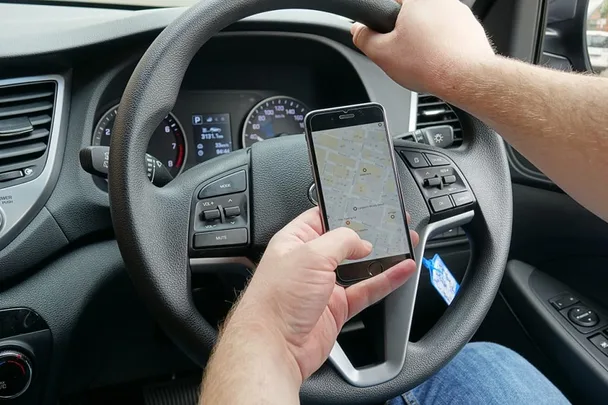Driving might be the only activity on the planet that the more you practice it, the worse you get. Weird, right? Pass your P-plate test and, in the months that follow, you’re a shining example of considerate driving, dutifully checking your mirrors, keeping your hands at “10-and-2” and staying glued to the prescribed speed limit.
But as the years pass, we get sloppy. Lazy, even. Suddenly our “10-and-2” becomes a single hand – or even a single finger – mounted at 12 o’clock exactly. Our mirrors become mere fashion accessories, and posted speed limits more of a guide than a hard and fast rule.
So allow us to present to you the five most common driving mistakes everyone is making, all of which have been ranked using the scientific method of which annoys us the most, and how to fix them.
1. Not paying attention
There’s a common misconception that, while looking at your phone for a moment is a potentially lethal distraction punishable by death (well, a whopping great fine and a hit to your demerit-point balance), fiddling with things that are actually attached to the car is no problem at all.
Spending two or three minutes tuning radio stations or Pandora playlists, punching in navigation settings or playing with your car’s ambient interior lighting settings (pink, blue, yellow, white!) while your car wobbles on up the road like a drunken slinky is fine, right? Wrong.
If we’ve learnt anything from watching the Seven Year Switch, it’s that just because something isn’t illegal, doesn’t mean it’s something you should be doing.
So pay attention. Please.
2: Over signalling, under signalling
We’ve all encountered the blinkered bandit, darting between lanes without warning (or indicating), or worse, taking a corner at the last moment without signalling, even though you’ve been waiting at said intersection to pull out and would have had plenty of time to do so if they’d JUST USED THEIR BLOODY INDICATOR.
Roundabouts are hotspots for this behaviour, where some drivers will turn into a flashing Christmas tree.
But there’s another light-based crime we can be found guilty of, and that’s over indicating. Roundabouts are hotspots for this behaviour, where some drivers will turn into a flashing Christmas tree at the entrance, in the middle, and on the exit of a roundabout, leaving those around them utterly confused as to their intentions.
So remember, flashing lights belong on emergency vehicles, so use your indicators. But use them sparingly.
3: So right, so wrong
Drive just about anywhere in Europe (though Italy and Germany are the most perfect examples) and freeways flow like a tightly choreographed ballet, with vehicles ducking in and out of the fast lane in near-perfect unison, like a team of mobile synchronised swimmers.
And that’s because there’s a simple law there that they follow to the letter: stay out of the fast lane unless overtaking. Hard to believe, then, that we have that same law in Australia, where it is as routinely ignored as the “restroom for paying customers” sign at service stations.
So here’s the deal: Please – please – keep left unless you’re overtaking. And that doesn’t mean overtaking a car travelling at 90km/h an hour by screaming past them at 91km/h so each overtaking manoeuvre takes minutes not seconds (trucks are absolute specials for this).
4. So close, so far
We know by now that tailgating is bad. Pressuring the car in front by sitting millimetres off their bumper isn’t just rude and obnoxious behaviour, but it’s also how accidents happen. Nervous drivers can make mistakes, and having the red-cheeked face of the driver behind them looming in their rear-view mirror is enough to make anyone nervous.
But equally, giving people too much space is also a problem. Most traffic snarls aren’t caused by accidents, but by poor driving, and leaving too much space between cars forces the traffic behind you to brake earlier and harder than they might normally need to, causing a flow-on effect to the thousands of cars behind them.
And there is perhaps no more frustrating a feeling than watching a single car get through a green light because the second vehicle in the queue has left three football fields of space between them.
So remember the two-second rule: pick a roadside marker, and wait for the car in front to pass it. If you’re passing the same point two seconds later, then your distance is perfect.
5. Safety net, not Skynet
While it’s true our cars are safer than ever before, and some will even do a lot of the safety work for you, those systems are designed as a safety net, not as the first line of defence.
We are rushing into a time when our cars will do everything for us, and where the driver will become just another passenger, but we’re not there yet.
Attempting to use autonomous emergency braking in place of your regular brakes, for example, is obviously fraught with danger, but so is expecting your Lane Keep Assist system to work every time you drop the wheel, or for your blind-spot monitoring system to detect everything (and everyone) beside your car.
We are rushing into a time when our cars will do everything for us, and where the driver will become just another passenger, but we’re not there yet.
So please, check your mirrors, check your blind spots and keep your hands on the wheel.
This article originally appeared on CarsGuide.










